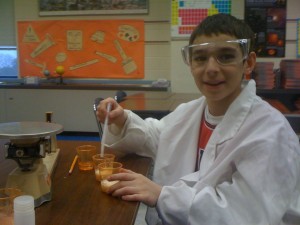Efficiency of Microencapsulation in Microgravity as Compared to Gravity

Brandon carefully measures and mixes the proper concentrations of ciprofloxacin and polyvinylpyrrolidone for flight on STS-134
Grade 6, Lincoln Hall Middle School
Principal Investigator: Brandon Gligor
Teacher Facilitator: Sharon Churchwell, NBCT, Science Teacher and Gifted Education Specialist
Proposal Summary:
This proposal will examine the efficiency of microencapsulation in the microgravity environment of space and compare it to the efficiency of microencapsulation in the gravity environment on Earth. I propose that the drug particles coated in microgravity will have a thicker coating and therefore a larger size and greater mass than the drug particles coated in gravity. I also propose that the coating will be more uniform on the particles formed in microgravity because the particles will stay in suspension longer and not touch each other as much in microgravity as in gravity so then the coating can form evenly on all sides of the drug particles. I want to see if drug particles can be coated by using a solvent and an anti-solvent. The solvent is going to be PVP, and PVA will be dissolved into the PVP. Then water with the drug particles suspended in it will be added, and the water should make the PVA come out of solution. This happens because water is an anti-solvent so it forces the PVA, which is not soluble in water, to come out of solution. The PVA that has come out of solution can possibly make a new particle, coat the wall of the chamber, or deposit on drug particles of ciprofloxacin. The drug particles will be measured, using equipment at AVEKA Group, before treatment and then after treatment in gravity and after treatment in microgravity.




